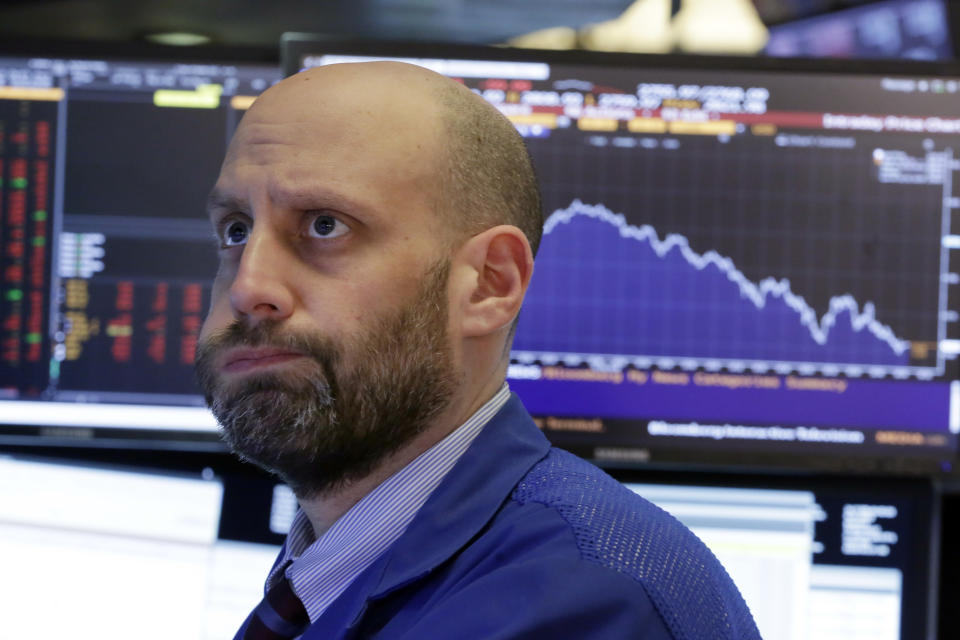TURNAROUND TUESDAY: Stocks close up 2% after wild trading session
After opening sharply lower and then spending much of the afternoon unchanged, U.S. stocks were ripped higher into the final hour of trading.
The Dow closed up 567 points, or 2.3%, the S&P 500 closed up 46 points, or 1.7%, and the Nasdaq closed up 148 points, or 2.1%.
Seconds after the opening bell on Tuesday, the Dow was down about 530 points, or 2.3%, the S&P 500 was down 49 points, or 1.8%, and the Nasdaq was down 137 points, or 2%. Within minutes, however, stocks rallied back sharply with the Dow rising as many as 300 points before moving back into the red later in the morning.
At the open and in pre-market trading, U.S. stocks were taking their lead from markets in Asia and Europe where markets sold off hard after Monday’s historic decline in the Dow.
Overnight, markets in Japan and Australia each lost more than 3% with the Nikkei in Japan falling 5%. Meanwhile, stocks in Europe were lower across the board with the Euro Stoxx 50 closing down almost 3%, the Dax in Germany falling almost 4%, the CAC in Paris down over 2%, and London’s FTSE 100 off 6%.
On Monday, the Dow lost 1,175 points, the largest point decline in the index’s history and good for a 4.6% loss. The S&P 500 lost 4.1%, or 113 points, and the tech-heavy Nasdaq fell 3.8%, or 273 points.
These losses followed a sharp decline into the weekend on Friday, with investors pointing to a number of factors as the source of this move lower in markets.
In the wake of Monday’s sell-off, many in markets were pointing to the massive surge in the VIX, an index which tracks market volatility, and the implosion of an ETN, or exchange-traded note, which seeks to expose investors to the inverse of the VIX.

Early Tuesday morning the VIX was trading above 50 for the first time since August 2015, when markets sold off on concerns related to the Chinese economy. Early this year the VIX was below 10. Near 3:00 p.m. ET the VIX was trading near 30.
On Tuesday, Credit Suisse, which sponsors the XIV ETF that tracks the inverse of the VIX, said it would redeem the note after an 80% decline after hours on Monday. XIV holders will get a cash payout on February 21 as a result of this action, and this redemption will likely trigger massive losses after the XIV gained over 180% in 2017 and became a popular way to bet against volatility, which hit historic lows in 2017.
Outside of this more esoteric market-plumbing issue rattling investors, starting last week and continuing into Monday the rise in Treasury yields was popularly seen as the proximate cause of stress in the stock market.
On Tuesday afternoon, the 10-year Treasury yield was sitting at 2.77%, lower than the four-year high of 2.85% we saw last week but still elevated relative to where rates have been in recent years. Warren Buffett, among others, has long made the argument that low interest rates make stocks more attractive on a relative basis; higher yields, in turn, make stocks less attractive.
Friday’s January jobs report, which showed the best wage growth since 2009, an indication of future inflation pressures in the economy, was cited as an additional reason for stocks coming under pressure.
Faster wage growth and a resulting pickup in inflation are concerns for markets as they could prompt the Federal Reserve to raise interest rates more quickly than expected. Higher interest rates both make stocks look less attractive on a relative basis and could choke off the current economic expansion.
Wall Street strategists early Tuesday were almost uniform in their contention that the market sell-off is disconnected from economic fundamentals that helped drive stocks to record highs in 2017 and early this year.
“We see the market selloff entirely disconnected from fundamentals,” said strategists at JP Morgan in a note Tuesday morning.
“While the sharp rise in volatility may contribute to further outflows from systematic strategies in the short-term, we believe fundamentals should ultimately prevail as companies continue to deliver double-digit earnings growth on US tax catalyst, global synchronized growth, and weaker USD… While it is hard to pinpoint the exact bottom of the current sell-off, we view this as an opportunity to start buying the dips.”
Scott Minerd, global CIO at Guggenheim, wrote Monday that, “I think that the setback [on Monday] is not over but we are approaching a bottom. This correction is a healthy development for the markets in the long run, and the equity bull market, while bloodied, is not broken… I still hold the opinion that the favorable economic fundamentals that are in place, where we are in the business cycle, the breadth of the market, and levels of current valuations are supportive of equities. Buying here will probably make investors happy campers later in the year, but the tug of war between stocks and bonds is just getting under way.”
This post will be updated throughout the day.
—
Myles Udland is a writer at Yahoo Finance. Follow him on Twitter @MylesUdland
Read more from Myles here:
One candidate for Amazon’s next headquarters looks like a clear frontrunner
Tax cuts are going to keep being a boon for the shareholder class
Auto sales declined for the first time since the financial crisis in 2017
Foreign investors might be the key to forecasting a U.S. recession
It’s been 17 years since U.S. consumers felt this good about the economy


